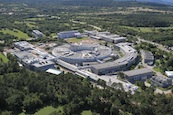
The European Association of National Research Facilities Association, ERF, aims at representing the wide variety of Research Infrastructures (RIs), built and funded by the European countries, but open to the use of all researchers admitted on the basis of quality from Europe and outside. To support and extend the EU capabilities, ERF wishes to engage not only with the communities represented in ERF but also more widely. This wider community includes governments (international, national and local), research funders, other RIs, higher education, industry and the citizen.
In this view, ERF has organized a series of topical seminars and workshops on:
- Open Access (Lund/Sweden, 2009)
- Human Capital (Villigen/Switzerland, 2010)
- Energy (Lund/Sweden, 2011 jointly with ESS and CERN), and
- Socio-economic impact (Hamburg/Germany, 2012).
The meetings have been of great benefit both to the research community (including ERF members) and to ERF itself as an organization. At present, ERF is in the process of expanding its capabilities and outreach, by transforming itself into a formal association with a legal status andwith membership open to all RIs either national or set-up as ERICs (European Research Infrastructure Consortia).
The ERF Workshop “Technology Transfer and Industrial Relations in Research Infrastructures” will bring together experts from research infrastructures, policy makers and industry to share real experiences, best practices and new challenges in the collaboration between industry and research. The scope of the workshop is also to underline the role of Research Infrastructures in the context of Innovation activities in Europe.
About Elettra
Elettra - Sincrotrone Trieste is a multidisciplinary international center of excellence, specialized in generating high quality synchrotron and free-electron laser light and applying it in materials science. Its mission is to promote cultural, social and economic growth through:
- Basic and applied research;
- Technical and scientific training;
- Transfer of technology and know-how.
The main assets of the research centre are two advanced light sources, the electron storage ring Elettra and the free-electron laser (FEL) FERMI, continuously (H24) operated supplying light of the selected "colour" and quality to more than 30 experimental stations on 27 beamlines. These facilities enable the international community of researchers from academy and industry to characterize material properties and functions with sensitivity down to molecular and atomic levels, to pattern and nanofabricate new structures and devices, and to develop new processes. Every year scientists and engineers from more than 50 different countries compete by submitting proposals to access and use time on these stations.
 |
 |
 |
 |
| Organising Committee | Contacts |
| Tamás Belgya, Centre for Energy Research | Marco Marazzi |
| Michel Bessière, Soleil | Cristina Modolo |
| Philippe Deblay, Soleil | Flavia Bottaro |
| Ornela De Giacomo, Elettra - Sincrotrone Trieste | |
| Celine Lory, Soleil | |
| Ilka Mahns, DESY | |
| Marco Marazzi, Elettra - Sincrotrone Trieste | |
| Edward Mitchell, ESRF | |
| Cristina Modolo, Elettra - Sincrotrone Trieste | |
| Carlo Rizzuto, Elettra - Sincrotrone Trieste | |
| Ian Tracey, STFC |